DeWalt DW919T Handleiding
Bekijk gratis de handleiding van DeWalt DW919T (6 pagina’s), behorend tot de categorie Zaklamp. Deze gids werd als nuttig beoordeeld door 35 mensen en kreeg gemiddeld 4.5 sterren uit 18 reviews. Heb je een vraag over DeWalt DW919T of wil je andere gebruikers van dit product iets vragen? Stel een vraag
Pagina 1/6

Flexible Floodlights
9.6, 12, 14.4, 18 Volt
DW913 (9.6 V), DW917 (12 V), DW918 (14.4 V),
DW919 (18 V)
– Use with DEWALT power packs and chargers (both sold
separately).
IF YOU HAVE ANY QUESTIONS OR COMMENTS ABOUT THIS
OR ANY DEWALT TOOL, CALL US TOLL FREE AT:
1-800-4-DEWALT (1-800-433-9258)
NOTE: Your DW913 flexible floodlight operates on a 9.6V power
pack (DW9061 or DW9062). Your DW917 flexible floodlight
operates on a 12V power pack (DW9071 or DW9072). Your DW918
flexible floodlight operates on a 14.4V power pack (DW9091). Your
DW919 flexible floodlight operates on a 18V power pack (DW9095
or DW9096). Power packs are sold separately.
WARNING: When using electric tools, basic safety precau-
tions should always be followed to reduce risk of fire,
electric shock, and personal injury, including the following:
READ ALL INSTRUCTIONS
SAVE THESE INSTRUCTIONS
Safety Rules for Flexible Floodlights
WARNING: DO NOT OPERATE FLASHLIGHT or charger
NEAR FLAMMABLE LIQUIDS OR IN GASEOUS OR EXPLOSIVE
ATMOSPHERES. INTERNAL SPARKS MAY IGNITE FUMES. Do
not expose Flexible floodlight or charger to rain or damp areas.
WARNING: Lens and bulb become hot during use.
• During or immediately after use, don’t lay flexible floodlight
flat on lens surface.
• Don’t touch lens surface when bulb is lit or immediately after
use.
• Handle flexible floodlight with care around any flammable
surface.
• If bulb has been lit, let flexible floodlight cool for several min-
utes before changing bulb.
Safety Rules for Chargers
1. Before using charger, read all instructions and cautionary
markings on (1) charger, (2) battery pack, and (3) product
using battery pack.
2. DANGER: Electrocution hazard. 120 volts are present at
charging terminals. Do not probe with conductive objects.
3. If battery pack case is cracked or damaged, do not insert into
charger. Danger of electric shock or electrocution.
4. The charger and battery pack are specifically designed to work
together. DO NOT attempt to charge the battery pack with any
chargers other than the ones in this manual.
5. Do not expose charger to rain or snow.
6. To reduce risk of damage to electric plug and cord, pull by plug
rather than cord when disconnecting charger.
7. Make sure cord is located so that it will not be stepped on,
tripped over, or otherwise subjected to damage or stress.
8. An extension cord should not be used unless absolutely
necessary. Use of improper extension cord could result in risk
of fire, electric shock, or electrocution.
9. Two wire cords can be used with 2 or 3 wire extension cords.
Only round jacketed extension cords should be used, and we
recommend that they be listed by Underwriters Laboratories
(U.L.) (C.S.A. in Canada.) The letters WA on the cord jacket
indicate that the cord is suitable for outdoor use.
10. An extension cord must have adequate wire size (AWG or
American Wire Gauge) for safety. The smaller the gauge num-
ber of the wire, the greater the capacity of the cable, that is 16
gauge has more capacity than 18 gauge. When using more
than one extension to make up the total length, be sure each
individual extension contains at least the minimum wire size.
Recommended Minimum Wire Size for Extension Cords
Total Length of Cord
25 ft. 50 ft. 75 ft. 100 ft. 125 ft. 150 ft. 175 ft.
7.6 m 15.2 m 22.9 m 30.5 m 38.1 m 45.7 m 53.3 m
Wire Size AWG
18 18 16 16 14 14 12
11. The charger is ventilated through slots in the top and the bot-
tom of the housing. Do not place any object on top of the charg-
er or place the charger on a soft surface that might block the
ventilation slots and result in excessive internal heat. Place the
charger in a position away from any heat source.
12. Do not operate charger with damaged cord or plug — have
them replaced immediately.
13. Do not operate charger if it has received a sharp blow, been
dropped, or otherwise damaged in any way; take it to an autho-
rized D
EWALT service center.
14. Do not disassemble charger; take it to an authorized D EWALT
service center when service or repair is required. Incorrect
reassembly may result in a risk of electric shock, electrocution
or fire.
15. To reduce risk of electric shock, unplug charger from outlet
before attempting any cleaning. Removing the battery pack will
not reduce this risk.
16. NEVER attempt to connect 2 chargers together.
17. DO NOT store or use the tool and battery pack in locations
where the temperature may reach or exceed 105°F (such as
outside sheds or metal buildings in summer).
18. The charger is designed to operate on standard household
electrical power (120 volts). Do not attempt to use it on any
other voltage!
Safety Rules for Batteries
1. Do not incinerate the battery pack even if it is severely dam-
aged or is completely worn out. The battery pack can explode
in a fire.
2. A small leakage of liquid from the battery pack cells may occur
under extreme usage or temperature conditions. This does not
indicate a failure. However, if the outer seal is broken and this
leakage gets on your skin:
a. Wash quickly with soap and water.
b. Neutralize with a mild acid such as lemon juice or vinegar.
c. If battery liquid gets into your eyes, flush them with clean
water for a minimum of 10 minutes and seek immediate
medical attention. ( The liquid is 25-35% Medical note:
solution of potassium hydroxide.)
3. Never attempt to open the battery pack for any reason. If the
plastic housing of the battery pack breaks or cracks, immedi-
ately discontinue use and do not recharge.
NOTE: Battery storage and carrying caps are
provided for use whenever the battery is out of the tool
or charger. Remove cap before placing battery in charger
or tool.
WARNING: Fire hazard. Do not store or carry battery so that
metal objects can contact exposed battery terminals. For
example, do not place battery in aprons, pockets, tool boxes, prod-
uct kit boxes, drawers, etc., with loose nails, screws, keys, etc. with-
out battery cap. Transporting batteries can possibly cause fires
if the battery terminals inadvertently come in contact with
conductive materials such as keys, coins, hand tools and the
like. The US Department of Transportation Hazardous Material
Regulations (HMR) actually prohibit transporting batteries in
commerce or on airplanes (i.e., packed in suitcases and carry-on
luggage) UNLESS they are properly protected from short circuits.
So when transporting individual batteries, make sure that the

battery terminals are protected and well insulated from materials
that could contact them and cause a short circuit.
Charging Procedure
DW9104, DW9106, DW9107, DW9108, DW9109
(1 HOUR CHARGERS) ONLY
1. Plug the charger into an appropriate AC power outlet.
2. Insert the battery pack into the charger, making sure the pack is
fully seated in the charger. The red (charging) light will blink
continuously indicating that the charging process has started.
3. The battery pack will be fully charged in about 1 hour under
most conditions. The completion of charge will be indicated by
the red light remaining ON continuously. The pack is fully
charged and may be used at this time or left in the charger.
DW9115 (15 MINUTE CHARGER) ONLY
1. Plug the charger into an appropriate AC power outlet. The
charger will beep twice and the red light will blink and then go
off.
2. Insert the battery pack into the charger, as shown in Figure 1,
making sure the pack is fully seated in the charger. The red light
will blink and the charger will beep once indicating the charging
process has started.
3. The battery pack will be fully charged in less than 15 minutes
under most conditions. This will be indicated by the red light
remaining ON and 3 audible beeps. The pack is fully charged
and may be used at this time or left in the charger.
Power Pack Insertion and Removal
To insert the power pack into your flexible floodlight, slide it into the
end of the light until it snaps into place. To remove the power pack,
depress the release buttons shown and withdraw the power pack.
Switch
To turn the light on, slide the switch forward. To turn it off, slide the
switch back.
Replacing the Light Bulb
Floodlight Cat. No Replacement Bulb Cat. No.
DW913 DW9023
DW917 DW9043
DW918 DW9063
DW919 DW9083
To replace the light bulb, first unscrew the lens holder. Pull the bulb
out of the spring, and insert a new bulb. Reinstall lens holder.
NOTE: Do not look directly into the flexible floodlight beam.
Spare Bulb Storage (Fig. 2)
To store a bulb, unscrew the lens holder and remove it. Inside the
body of the flexible floodlight is the storage socket. To remove the
bulb, pull it up and out of the storage area.
NOTE: Removing a pack from the charger and immediately
inserting it into the flexible floodlight may weaken bulb life.
The RBRC™ Seal
The RBRC™ (Rechargeable Battery Recycling
Corporation) Seal on the nickel-cadmium battery
indicates that the costs to recycle the battery at the
end of its useful life have already been paid by
DEWALT. In some areas, it is illegal to place spent
nickel-cadmium batteries in the trash or municipal solid waste
stream and the RBRC program provides an environmentally
conscious alternative.
RBRC in cooperation with DEWALT and other battery users, has
established programs in the United States to facilitate the collection
of spent nickel-cadmium batteries. Help protect our environment
and conserve natural resources by returning the spent nickel-
cadmium battery to an authorized service center or to your local
retailer for recycling. You may also contact your local recycling
center for information on where to drop off the spent battery.
Three Year Limited Warranty
DEWALT will repair, without charge, any defects due to faulty mate-
rials or workmanship for three years from the date of purchase.
This warranty does not cover part failure due to normal wear or tool
abuse. For further detail of warranty coverage and warranty repair
information, visit www.dewalt.com or call 1-800-4-DEWALT (1-800-
433-9258). This warranty does not apply to accessories or damage
caused where repairs have been made or attempted by others.
This warranty gives you specific legal rights and you may have
other rights which vary in certain states or provinces.
In addition to the warranty, DEWALT tools are covered by our:
1 YEAR FREE SERVICE
DEWALT will maintain the tool and replace worn parts caused by
normal use, for free, any time during the first year after purchase.
90 DAY MONEY BACK GUARANTEE
If you are not completely satisfied with the performance of your
DEWALT Power Tool, Laser, or Nailer for any reason, you can
return it within 90 days from the date of purchase with a receipt for
a full refund – no questions asked.
RECONDITIONED PRODUCT: Reconditioned product is covered
under the 1 Year Free Service Warranty. The 90 Day Money Back
Guarantee and the Three Year Limited Warranty do not apply to
reconditioned product.
FIG. 1 FIG. 2
LENS HOLDER
PORTE-LENTILLE
SUJETADOR DE LA LENTE
BULB
AMPOULE
BOMBILLA
BATTERY RELEASE BUTTON
BOUTON DE DÉGAGEMENT
DE LA PILE
BOTON DE LIBERACION DE
LA BATERIA
SPARE BULB STORAGE
RANGEMENT DE L’AMPOULE
DE RECHANGE
COMPARTIMIENTO PARA
BOMBILLA DE REPUESTO
POWER PACK (NOT INCLUDED)
ENSEMBLE DE PILES
(NON COMPRIS)
BATERIA (NO INCLUIDA)
SWITCH
INTERRUPTEUR
INTERRUPTOR

5. Protéger de la pluie ou de la neige.
6. Il vaut mieux tirer sur la fiche que sur le cordon pour débrancher
le chargeur afin de minimiser les risques de dommages à la
fiche et au cordon.
7. S’assurer que le cordon du chargeur est situé de sorte qu’on ne
puisse marcher dessus, y trébucher, l’endommager ou le
soumettre à toute autre contrainte.
8. Ne pas utiliser de cordon de rallonge, sauf en cas de nécessité
absolue. L’utilisation d’un cordon de calibre inapproprié
présente des risques d’incendie, de secousses électriques ou
d’électrocution.
9. Les cordons bifilaires peuvent servir avec des cordons de
rallonge bifilaires ou trifilaires. Il faut seulement utiliser des
cordons de rallonge à gaine ronde. Il est conseillé d’utiliser des
cordons homologués par l’organisme UL (CSA au Canada).
Les lettres WA sur le cordon signifient que le cordon est conçu
pour l’extérieur.
10. Le calibre du cordon de rallonge doit être approprié (AWG ou
calibre américain des fils) par mesure de sécurité. Le numéro
de calibre du fil est inversement proportionnel à la capacité du
cordon. Ainsi, un cordon de calibre 16 a une capacité
supérieure à un cordon de calibre 18. Lorsqu’il est nécessaire
d’utiliser plus d’un cordon de rallonge, veiller à ce que chaque
cordon ait au moins le calibre minimal.
Calibre minimal des cordons de rallonge
Longueur totale du cordon
25 ft. 50 ft. 75 ft. 100 ft. 125 ft. 150 ft. 175 ft.
7,6 m 15,2 m 22,9 m 30,5 m 38,1 m 45,7 m 53,3 m
Intensité AWG
18 18 16 16 14 14 12
11. La ventilation du chargeur se fait par les fentes qui se trouvent
sur le dessus et le dessous du boîtier. Ne rien placer sur le
chargeur ni déposer le chargeur sur une surface molle qui
pourrait bloquer les orifices de ventilation et provoquer une
chaleur excessive à l’intérieur. Éloigner le chargeur de toute
source de chaleur.
12. Ne pas utiliser le chargeur lorsque le cordon ou la fiche sont
défectueux. Les remplacer immédiatement.
13. Ne pas utiliser le chargeur lorsqu’il a reçu un coup brusque, qu’il
est tombé ou qu’il est endommagé. Le confier à un centre de
service DEWALT autorisé.
14. Ne pas démonter le chargeur; en confier les réparations ou
l’entretien à un centre de service DEWALT autorisé. Le
montage inapproprié présente des risques de secousses
électriques, d’électrocution ou d’incendie.
15. Afin de minimiser les risques de secousses électriques,
débrancher le chargeur avant de le nettoyer. On diminue
également les risques en enlevant au préalable l’ensemble de
piles.
16. NE JAMAIS tenter de relier deux chargeurs.
17. NE PAS ranger l’outil dans un endroit où la température peut
atteindre ou dépasser 40 °C (105 °F) (comme dans une
remises métallique extérieure en été).
18. Le chargeur est conçu pour fonctionner sur une alimentation
standard de 120 volts. Ne pas tenter de l’utiliser sous toute
autre tension.
Mesures de sécurité relatives aux piles
1. Ne pas incinérer l’ensemble de piles même s’il est très
endommagé ou complètement usé. La chaleur des flammes peut
le faire exploser.
2. Il peut se produire une légère fuite du liquide excitateur des
piles dans des conditions d’utilisation et de chargement
difficiles ou en cas de température extrême. Une telle fuite ne
serait pas nécessairement un signe de panne. Toutefois, si ce
liquide s’échappe par une rupture du joint étanche du boîtier et
atteint la peau, il faut :
a. laver immédiatement à l’eau et au savon;
b. neutraliser à l’aide d’un acide doux (comme du jus de citron
ou du vinaigre);
Projecteurs flexibles de
9,6, 12, 14,4 et 18 volts
Modèles DW913 (9,6 V), DW917 (12 V),
DW918 (14,4 V) et DW919 (18 V)
– Utiliser avec des ensembles de piles et des chargeurs
DEWALT (vendus séparément).
POUR TOUT RENSEIGNEMENT SUR L’OUTIL OU TOUT AUTRE
OUTIL DEWALT, COMPOSER SANS FRAIS LE :
1 800 4-DEWALT (1 800 433-9258)
NOTE : Le projecteur flexible, modèle DW913, s’alimente à l’aide
d’un ensemble de piles de 9,6 volts (modèle DW9061 ou DW9062).
Le projecteur flexible, modèle DW917, s’alimente à l’aide d’un
ensemble de piles de 12 volts (modèle DW9071 ou DW9072). Le
projecteur flexible, modèle DW918, s’alimente à l’aide d’un ensem-
ble de piles de 14,4 volts (modèle DW9091). Le projecteur flexi-
ble, modèle DW919, s’alimente à l’aide d’un ensemble de piles de
18 volts (modèle DW9095 ou DW9096). Les ensembles de piles
sont vendus séparément.
AVERTISSEMENT : Afin de réduire les risques d’incendie, de
secousses électriques ou de blessures lorsqu’on utilise des
outils électriques, il faut toujours respecter les mesures de sécurité
suivantes.
LIRE TOUTES LES DIRECTIVES
CONSERVER CES MESURES
À TITRE DE RÉFÉRENCE
Mesures de sécurité relatives aux
projecteurs
AVERTISSEMENT : NE PAS UTILISER LA LAMPE DE POCHE
NI LE CHARGEUR PRÈS DE LIQUIDES INFLAMMABLES NI
DANS UN ENDROIT RENFERMANT DES VAPEURS INFLAM-
MABLES OU EXPLOSIVES. DES ÉTINCELLES DANS CES PRO-
DUITS POURRAIENT ENFLAMMER LES VAPEURS.
PROTÉGER LE PROJECTEUR FLEXIBLE OU LE CHARGEUR
DE LA PLUIE ET DES ENDROITS HUMIDES.
AVERTISSEMENT : La lentille et l’ampoule deviennent brûlants
pendant l’utilisation.
• Pendant l’utilisation ou immédiatement après s’être servi du
projecteur, ne pas toucher à la lentille.
• Ne pas toucher à la surface de la lentille une fois l’ampoule
allumé ou immédiatement après qu'il a été éteint.
• Manipuler le projecteur flexible avec soin à proximité de toute
surface inflammable.
• Lorsque l’ampoule a fonctionné, laisser refroidir le projecteur
pendant plusieurs minutes avant de remplacer l’ampoule.
Importantes mesures de sécurité
relatives aux chargeurs
1. Avant d’utiliser le chargeur, lire toutes les directives et les mises
en garde qui se trouvent (1) sur le chargeur, (2) sur l’ensemble
de piles et (3) sur le produit utilisant l’ensemble de piles.
2. DANGER : Risques d’électrocution. Les bornes de charge
reçoivent une tension de 120 volts. Ne pas les toucher avec des
objets conducteurs.
3. Ne pas insérer un ensemble de piles cassé ou endommagé
dans le chargeur. Cela présente des risques de secousses
électriques ou d’électrocution.
4. Le chargeur et l’ensemble de piles sont conçus pour
fonctionner ensemble. NE PAS tenter de charger l’ensemble de
piles avec un autre chargeur que ceux mentionnés dans le
présent guide.
FREE WARNING LABEL REPLACEMENT: If your warning labels
become illegible or are missing, call 1-800-4-DEWALT for a free
replacement.
Product specificaties
| Merk: | DeWalt |
| Categorie: | Zaklamp |
| Model: | DW919T |
Heb je hulp nodig?
Als je hulp nodig hebt met DeWalt DW919T stel dan hieronder een vraag en andere gebruikers zullen je antwoorden
Handleiding Zaklamp DeWalt
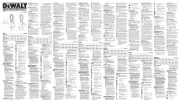
23 Mei 2025

18 Mei 2023

6 Mei 2023

5 Mei 2023

11 April 2023

6 April 2023

31 Maart 2023

8 Maart 2023

4 Maart 2023

27 Februari 2023
Handleiding Zaklamp
- Topeak
- Blackburn
- Energizer
- IVT
- Silva Schneider
- Maverick
- MPOWERD
- Eisemann
- PowerSmith
- Livarno
- GoGEN
- Silverline
- Sanyo
- Kayoba
- Barska
Nieuwste handleidingen voor Zaklamp
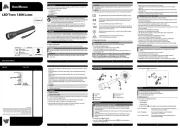
16 Juli 2025
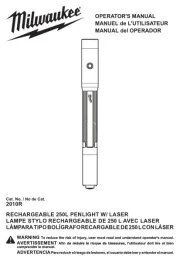
15 Juli 2025
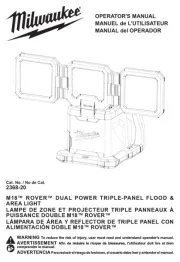
14 Juli 2025
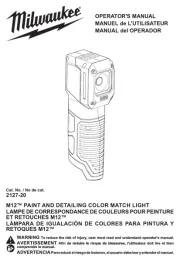
14 Juli 2025
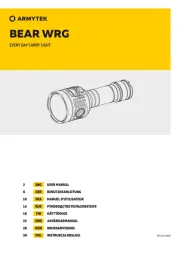
14 Juli 2025
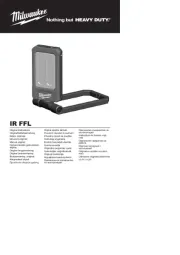
14 Juli 2025
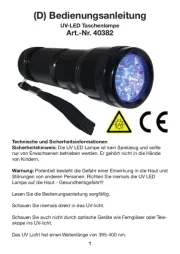
10 Juli 2025
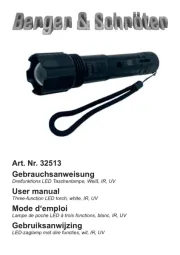
5 Juli 2025
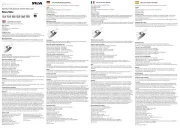
4 Juli 2025
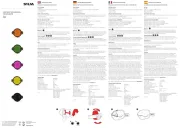
4 Juli 2025